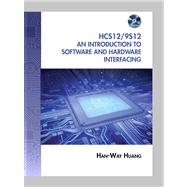
Note: Supplemental materials are not guaranteed with Rental or Used book purchases.
Purchase Benefits
What is included with this book?
| Preface | |
| Introduction to the HCS12 | |
| Microcontroller Objectives Number System Issue | |
| The Computer Hardware Organization | |
| The processor Microprocessor | |
| Microcontroller Embedded Systems Memory | |
| Magnetic Memory | |
| Optical Memory | |
| Semiconductor Memory | |
| Non-Volatile and Volatile Memory | |
| Random Access Memory | |
| Read-Only Memory | |
| Memory System | |
| Operation Read | |
| Operation Write | |
| Operation Program Execution | |
| The circuit of the Program Counter | |
| Where does the Processor Start to Execute Program? | |
| Instruction Execution Process Instruction | |
| Sequence Example Instruction Execution Process | |
| Overview of the HCS12 | |
| Microcontroller The HCS12 | |
| CPU Registers HCS12 | |
| Addressing Modes | |
| Inherent Mode | |
| Immediate Mode | |
| Direct Mode | |
| Extended Mode | |
| Relative Mode | |
| Indexed Addressing Modes | |
| Indexed Addressing Modes with Constant Offsets | |
| Indexed Addressing Mode with Offset in an Accumulator | |
| Auto Pre/Postdecrement/Increment | |
| Indexed Addressing Modes 16-bit | |
| Offset Indexed-Indirect Mode | |
| Accumulator D Indirect Indexed Addressing | |
| Addressing More than 64 Kbytes | |
| A Sample of HCS12 | |
| Instructions The Load and Store | |
| Instructions Transfer and Exchange | |
| Instructions Move | |
| Instructions Add and Subtract | |
| Instructions Instruction Queue | |
| Summary | |
| Exercise 2 | |
| HCS12 Assembly Programming Objectives | |
| Assembly Language Program Structure | |
| The Label Field | |
| The Operation Field | |
| The Operand Field | |
| The Comment Field Assembler Directives | |
| Software Development Issues | |
| Writing Programs to Do Arithmetic Carry/Borrow Flag | |
| Multiprecision Addition Subtraction and the C Flag | |
| Multiprecision Subtraction Binary-Coded-Decimal (BCD) | |
| Addition Multiplication and Division Program | |
| Loops Condition Code | |
| Register Branch Instructions | |
| Compare and Test Instructions | |
| Loop Primitive Instructions | |
| Implementation of Looping Constructs | |
| Decrementing and Incrementing Instructions | |
| Bit Condition Branch Instructions | |
| Instructions for Variable Initialization | |
| Shift and Rotate Instructions | |
| Boolean Logic Instructions | |
| Bit Test and Manipulate Instruction | |
| Program Execution Time | |
| The Multiply and Accumulate Instruction EMACS | |
| Summary | |
| Exercises 3 | |
| Hardware and Software Development Tools for the HCS12 | |
| Objectives HCS12 | |
| Members Development Tools for the HCS12 | |
| Software Development Tools | |
| Hardware Development Tools | |
| Types of HCS12 Demo boards | |
| The Dragon12-Plus Demo Board | |
| The D-Bug12 Monitor | |
| The D-Bug12 Operating Modes EVB Mode | |
| Using a Demo Board with the D-Bug12 | |
| Monitor Starting the MiniIDE Communicating with the Demo Board | |
| Using the D-Bug12 Commands Entering an Assembly Program | |
| Assembling the Program Downloading the S-Record | |
| File onto the Demo Board for Execution | |
| Running and Debugging the Program | |
| Other D-Bug12 Modes | |
| The Pod Mode | |
| The Jump-to-EEPROM Mode | |
| The Bootloader Mode | |
| Tips for Assembly Language Program Debugging | |
| Syntax Errors | |
| Logical Errors | |
| Using the CodeWarrior | |
| Building Software Project | |
| Using the CodeWarrior Project | |
| Setup Source Code Entering Project | |
| Build Program Debugging BDM | |
| Serial Interface | |
| The BDM-Based Debugger | |
| Summary | |
| Lab Exercises and Assignment 4 | |
| Advanced Assembly Programming Objectives | |
| Introduction Stack Indexable Data Structures | |
| Strings Data Conversion Character and Word Counting | |
| Word Matching | |
| String Insertion Subroutines | |
| Issues in Subroutine Calls | |
| Parameter Passing Result Returning Allocation of Local Variables | |
| The Stack Frame Examples of Subroutine Calls | |
| Finding the Greatest Common Divisor | |
| Multiple Byte Division Bubble Sort | |
| Finding the Square Root | |
| Using the D-Bug12 Functions to Perform I/O Operations | |
| Calling D-Bug12 Functions from Assembly Language | |
| Descriptions of Callable Functions | |
| Using the D-Bug12 Functions | |
| Tips for Program Debugging Involving | |
| Subroutine Calls What to Do When the Program | |
| Gets Stuck General Debugging Strategy | |
| Summary Exercises Lab Exercises and Assignments 5 | |
| C Language Programming Objectives | |
| Introduction to C Types, Operators, and Expressions | |
| Table of Contents provided by Publisher. All Rights Reserved. |
The New copy of this book will include any supplemental materials advertised. Please check the title of the book to determine if it should include any access cards, study guides, lab manuals, CDs, etc.
The Used, Rental and eBook copies of this book are not guaranteed to include any supplemental materials. Typically, only the book itself is included. This is true even if the title states it includes any access cards, study guides, lab manuals, CDs, etc.